In my review of the Prosopaedia I went over the history of the last few years of RuneQuest publications. The Gloranthan fandom was waiting for something big to happen, based on much teasing and many sneak peeks from Chaosium. The clouds darkened, electricity built up in the air… and now a bolt of light blinds our eyes! Thunder cracks! Take 1D6 of damage to a random location!
Okay, please excuse the heavy-handed game metaphors, I’m excited to be holding, at last, the “Lightbringers” volume of the Cults of RuneQuest!
Released concurrently to much marketing fanfare with the “Earth Goddesses” volume (which I’ll review in a few weeks), these two books are the first in the new “Cults of RuneQuest” series to describe the playable cults of Glorantha at length and in depth. Or, as I like to say: RuneQuest finally gets splatbooks! Has the game advanced to the 1990s? Are we getting some metaplot heavy scenario books next? Is Chaosium going to get acquired by some online gaming company? I’m joking, of course (well, partially), because, again, I’m excited. This year is gearing up to be a very good year for RuneQuest players with disposable income.
Before we head further into the matter at hand, please note that I received a review copy from Chaosium. Big thanks to Brian and Dustin! The book is available in hardcover and PDF from Chaosium, or in PDF from DriveThruRPG (affiliate link).
Behold the Lightbringers!
From the first time you take a glance at the Cults of RuneQuest: The Lightbringers, you know know Chaosium means business. The bombastic cover art by Loic Muzy makes you want to grab a weapon and charge naked and screaming into a shield wall. The layout by Simeon Cogswell departs elegantly from the previous RuneQuest books, pulling you in before settling into the comfortable rhythm of cult write-ups. A majority of the inside art are large, often full-page, pieces. The curse present at the beginning of all RuneQuest books is four times as powerful and deadly as usual. Chaosium isn’t pulling any punches.
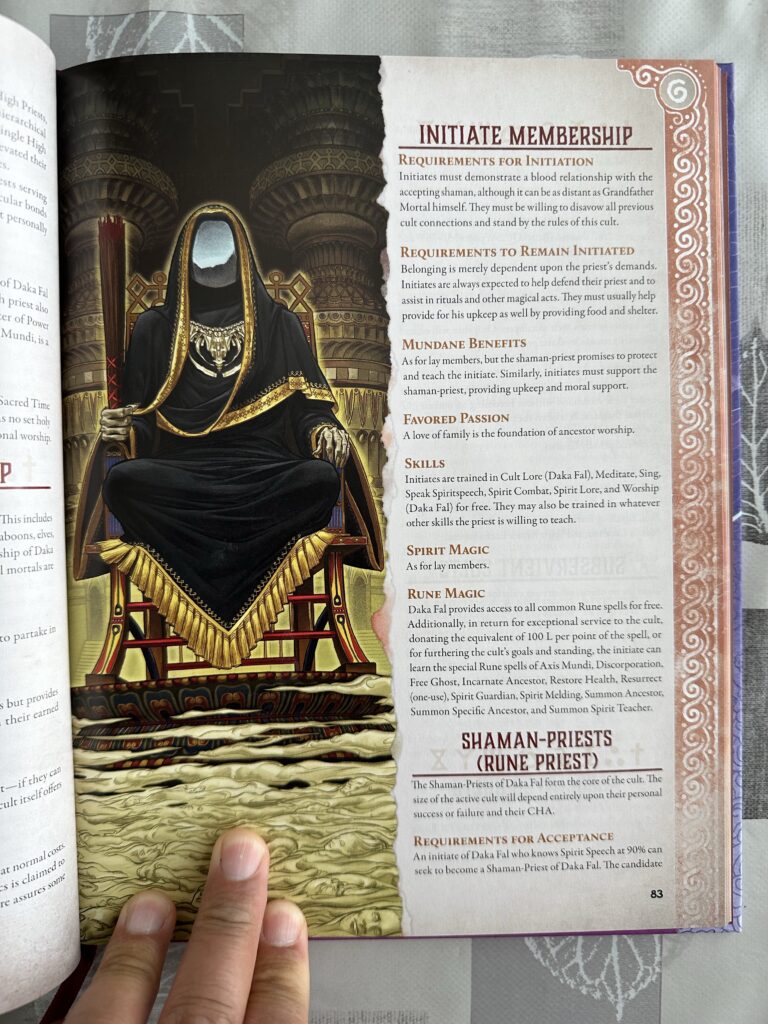
In my original flip-through of the book, I kept stopping to look at the pretty drawings. There is arguably no piece in this book that is less than “good”. There is a large majority that are “great”, and a few that are honestly “amazing”, “jaw-dropping”, or “I have to show this to my players right now”. A few of my favourite pieces include “Daka Fal on his throne”, “Gagarth rides his eight-legged beast”1Odin wants his horse back, and “my Humakti adventurer did some mushrooms at the death metal concert and accidentally cast Sword Trance”.

As I started reading properly, I found that this Lightbringers book was a little better edited and proof-read on average than the previous entries in the RuneQuest Glorantha line. It’s obviously not perfect (no book ever is), and at the time of writing there are two pages of corrections on the official BRP Central thread (including a few corrections filed by yours truly). A few of these corrections are actually important, so I recommend you do skim the thread. But overall I got the impression that Chaosium improved their production process on that front. I’m not the only one who remarked on this, so I’m inclined to say it’s not just in my head.
Where Do Babies Come From?
While the cult write-ups make up the bulk of the book’s page count (about 140 pages out of the 168 or so total), the preamble chapters can’t be ignored. They establish a few foundational concepts, including of course who the Lightbringers are and what was their Quest2No information about what their favourite colour is, however.. That Quest is introduced in a very concise and plain way, focusing on what it really accomplished and why it’s important, instead of getting sidetracked with how it went (you learn those details later). In fact, I found that the Lightbringers book, overall, presented many elements of lore in a somewhat simpler and more straightforward way than the previous lines of Gloranthan games. This is good news for newcomers to the setting.
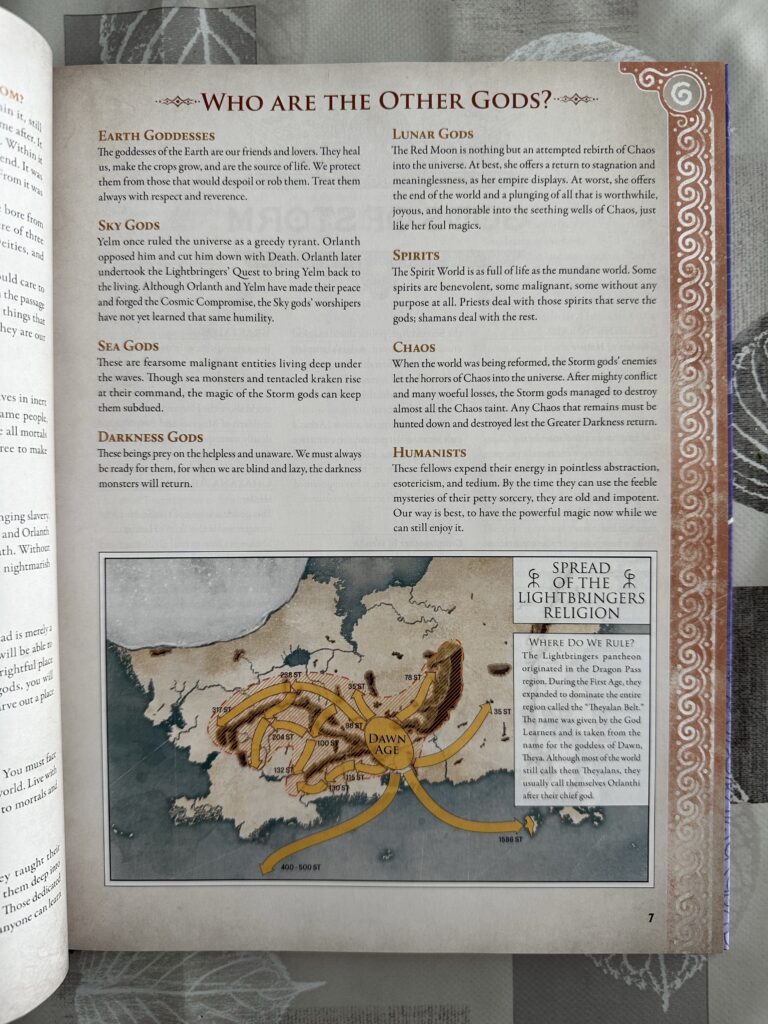
Another nice part of the introduction is dedicated to the Orlanthi pantheon’s point of view on life, the universe, and everything3Yes I’m starting to abuse movie references.. In a way somewhat reminiscent of the old HeroQuest Voices supplement, we learn (again, according to the Orlanthi) where the world came from, why people die, why we are here, and so on. Even better, we also get a subjective description of the other gods and cultures. This establishes a good baseline for roleplaying worshippers of the Lightbringers pantheon. Again, this is good for newcomers.

Several other bits here deserve a shout-out:
- A section called “Gods of Storm” has 50 or so entries that present a subset of the previously released Prosopaedia, shortened and edited from the point of view of the Lightbringers’ worshippers. This provides some context and information for various topics mentioned throughout the book, and even includes a pretty lengthy narration of the Lightbringers’ Quest that isn’t present in the Prosopaedia.
- A wonderful genealogy of the Lightbringers, drawn by Katrin Dirim in a mix of Mesoamerican and Mesopotamian style, lets you keep track of who’s related to whom.
- The nice map showing the spread of the Lightbringers religion in the Dawn Age even explains what “Theyalan” means, a term that notoriously shows up in the rulebook without really being explained!
It looks to me like the authors have gone through a lot of effort to craft this introductory section. It gives the reader the necessary information to grasp the Lightbringers pantheon without getting sidetracked or overloaded. Knowing a fair bit about Glorantha before hand, it’s of course hard for me to evaluate whether this succeeds, but it does look well done to me.
The only problem here is the evidence that, once again, Chaosium can’t release books in the correct order: we are told that the Cults of RuneQuest: Mythology book is recommended (on the same level as the rulebook itself), even though it’s only coming later this year. This is a problem that will fix itself soon, of course, but it causes a bit of head scratching in some places. For instance, some of the cult write-ups make obscure mentions of skill limits for Rune Priests. Only old-hands would remember that Cults of Prax includes a “Sample Cult” in its introduction, explaining the cult write-up format and giving general rules such as Rune Priests being limited to DEX×5 for their Manipulation skills. I’m pretty sure that these generalities will be contained in the upcoming Mythology book. In the meantime, this is a bit unfortunate.
What Class Am I Again?
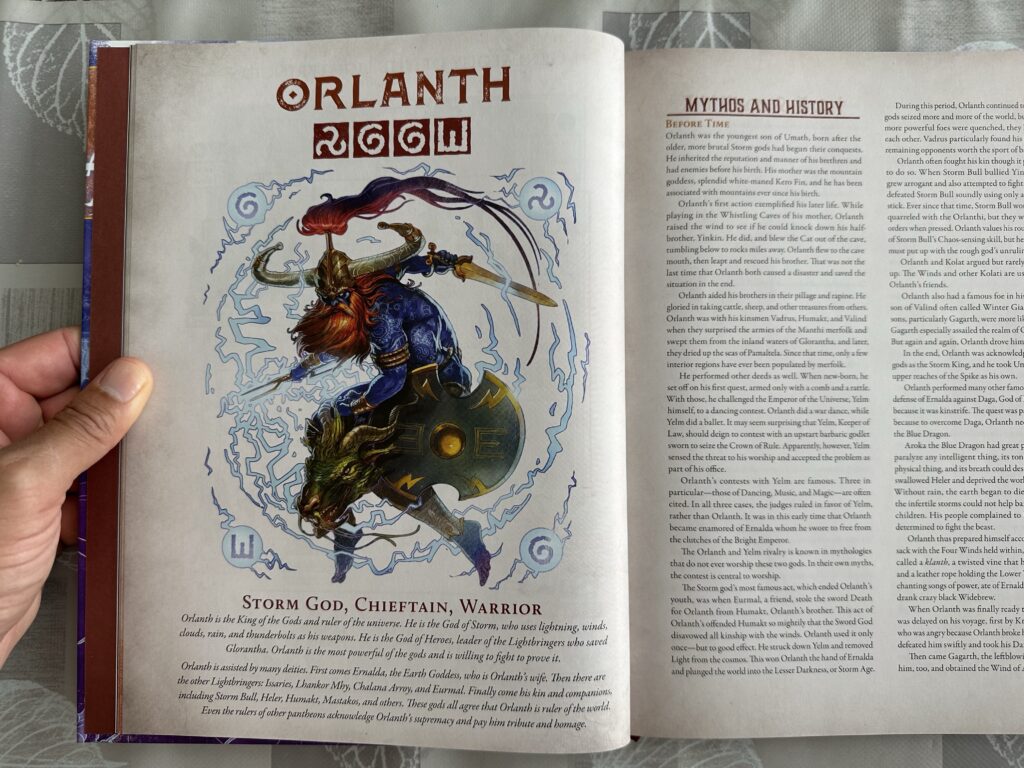
The piece de resistance in the Lightbringers book is of course the write-ups of 19 cults related to Orlanth’s little friends circle. The write-ups vary in size from a whooping 23 pages for the Orlanth cult itself, down to 4 pages for some of the minor cults.
The cult write-ups begin with the 5 (out of 7) Lightbringers deities that can actually be worshipped. Orlanth is first, of course. Then, in alphabetical order, we have Chalana Arroy, Eurmal, Issaries, and Lhankor Mhy. The other two Lightbringers, Flesh Man and Ginna Jar, are mentioned but aren’t worshipped and therefore do not get a write-up. The rest of the book describes 14 extra cults of associated and related deities, again in alphabetical order: Barntar, Daka Fal, Foundchild, Gagarth, Heler, Humakt, Lanbril, Mastakos, Odayla, Storm Bull, Valind, Waha, Ygg, and Yinkin.
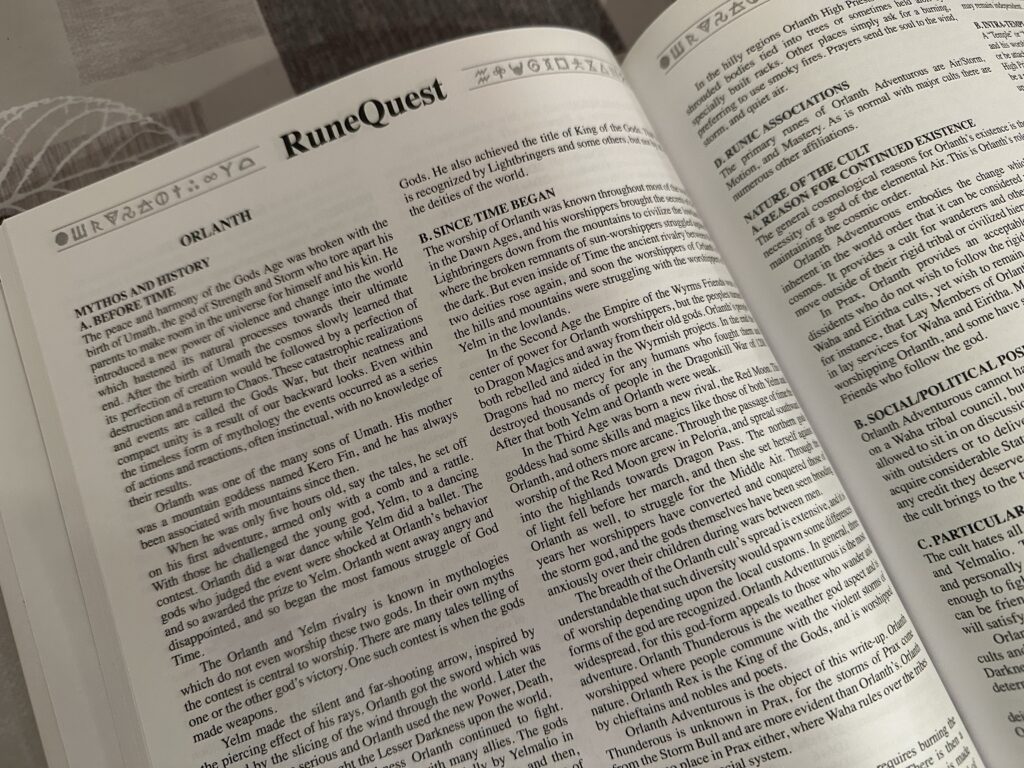
The format of each cult chapter is only slightly expanded from the venerable format established in RuneQuest 2nd edition, back in 1978, and popularized in the classic supplements Cults of Prax and Cults of Terror, in 1979 and 1981 respectively. Talk about a proven recipe!
Mythos, Without Tentacles
The first part of each cult write-up is “Mythos and History”, where we are told about the deity and what cool things they did. Some of the deities get only one or two defining myths, but the major gods and goddesses get several extra anecdotes. For instance Orlanth gets many side-quests, and Eurmal gets a ton of delightfully random (and sometimes intriguing) misfits.
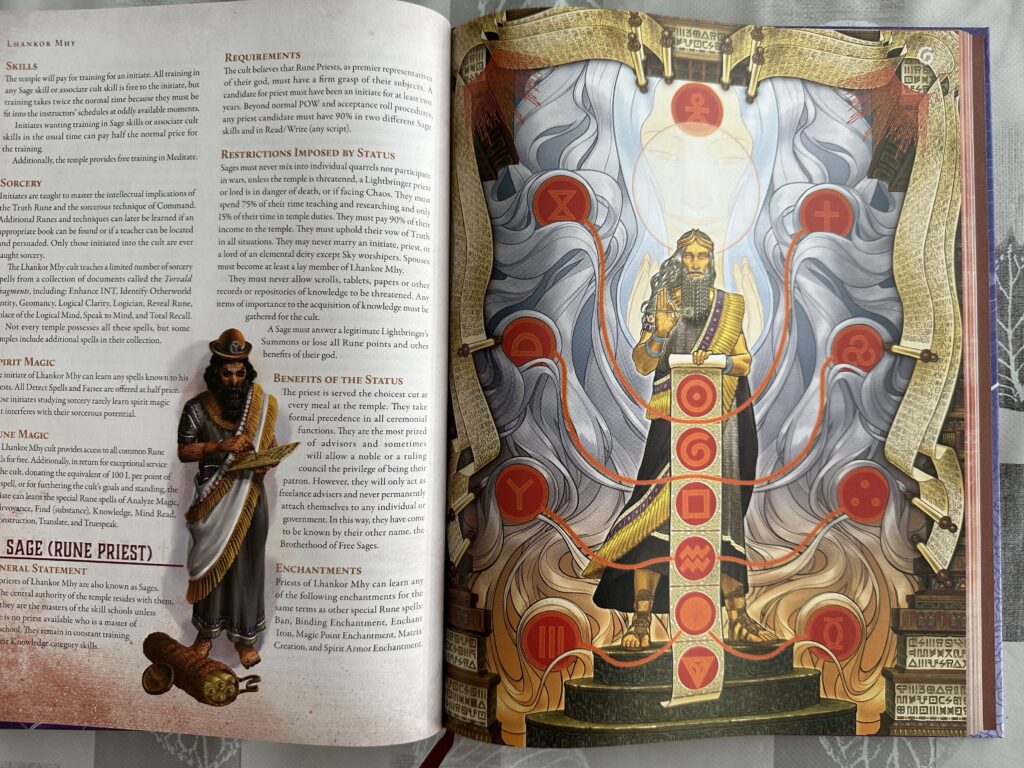
In many cases, these stories are pretty nice, functioning the way a myth is supposed to function. That is, they explain how the order of the natural world came to be, why people do the things they do, or why society has to function in a particular way. Occasionally, though, a deity’s mythos feels a bit empty, like for instance Yinkin’s which only reads like “stuff that happened”. On the plus side, this book does justify the existence of the Yinkin cult a lot better than the rulebook. RuneQuest included three hunter cults without much differentiation besides “do you prefer cats, dogs, or bears?“. Here we get a more complete picture: Yinkin is an absolutely minuscule cult for crazy cat people, Odayla is for people living off-the-grid in the forest, and Foundchild is the nomadic hunter’s deity.
In any case, the “Mythos and History” section often contains useful material for the gamemaster who needs to prepare for a heroquest, describe a worship ceremony, or simply add some flavour to an NPC or location. Even better, new additions to the old cult write-up format include a short description of the deity’s Otherworld Home, and their Iconography. The former basically tells you where and when on the God Plane you end up if you start a heroquest from this deity’s sacred grounds, and the latter gives a couple of options to describe that deity in a heroquest encounter, or in art on the mundane plane. Again, I personally find this quite useful!
Levelling Up
Most of the gaming material is contained in the three “levels” of membership available for each cult: lay membership, Initiate membership, and Rune levels (Rune Priest, Rune Lord, sometimes Shaman and/or God-talker). Given how polytheistic societies work, don’t ignore the lay membership sections: your players might end up joining many cults at that level, especially since some of them provide a few nice benefits for little commitment.

The most common new gameplay elements are the “new” spirit magic and Rune spells. I put “new” in quotes, of course, since almost all of these spells were already present in the Red Book of Magic. But here we finally see what deity they’re related to. This sometimes gives me a better appreciation for the spell, such as Meld Form and Proteus which give Mastakos the ability to change into whatever animal provides the best and fastest way to race through a given environment. Other times, it makes me sad, such as Valind’s super lame Decrease Temperature spell. I’ll be home-ruling that one and make my Valind worshippers less laughable and more scary, thank you very much.
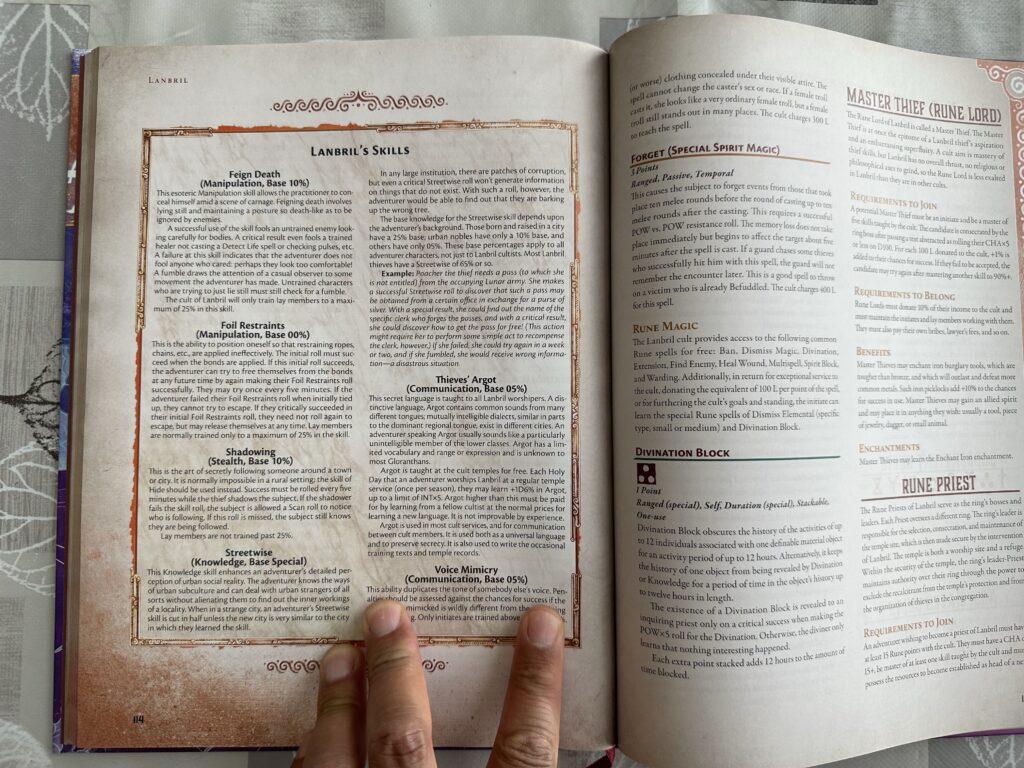
There are also several new skills across a few cults. I know that some of you love this stuff and can’t get enough of it, while others, who already sigh at the number of skills present on the character sheet, will shake their head at yet more skills. I tend to be part of the latter group but hey, if you’re part of the former, have fun with skills like “Ski” or “Feign Death”!
Spirits, And Where to Find Them
Yet another bit of information I appreciate is the section on spirits involved with a cult. This is useful for describing a new cult spirit summoned by an adventurer or coming up with a fancy allied spirit for an NPC. If someone messes up, there’s a description of the Spirit of Reprisal, often including fun or painful ways that it punishes the transgressor. On occasion, a cult even includes extra spirits such as well-known heroes worshipped for this or that special feat.
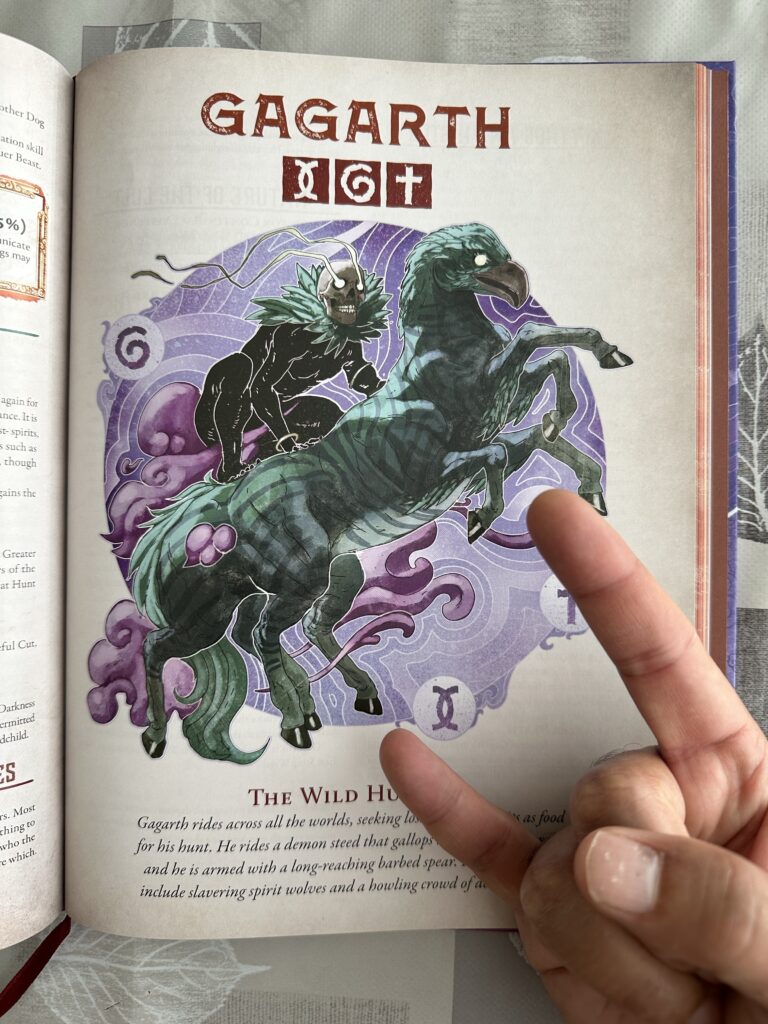
The only downside is that some of the spirit descriptions are almost useless. For instance, Lhankor Mhy is served by “spirits of knowledge”, and Issaries by “spirits of roads”. What do these look like? No idea… may I suggest that the latter are the spirits of the roadkill?
Let’s Go on a Pilgrimage
One of the interesting aspects of these cult write-ups is how they hint at the whole of Glorantha. While the rulebook was focused on the core Homelands, and the old Cults of Prax was focused on, well, Prax, the Lightbringers book tries to be global. There is a heavy bias towards Dragon Pass, of course, but many other places are also mentioned, like Peloria, Maniria, Ralios, Kralorela, and more. Often, the text pinpoints very specific places, such as a famous Chalana Arroy heroine in Maslo, Mastakos’ temples in Melib, or Odayla’s sacred hills in Sylila and Aggar. This broadens the scope of play in a pretty exciting way, assuming you have a gamemaster brave enough to take you there.
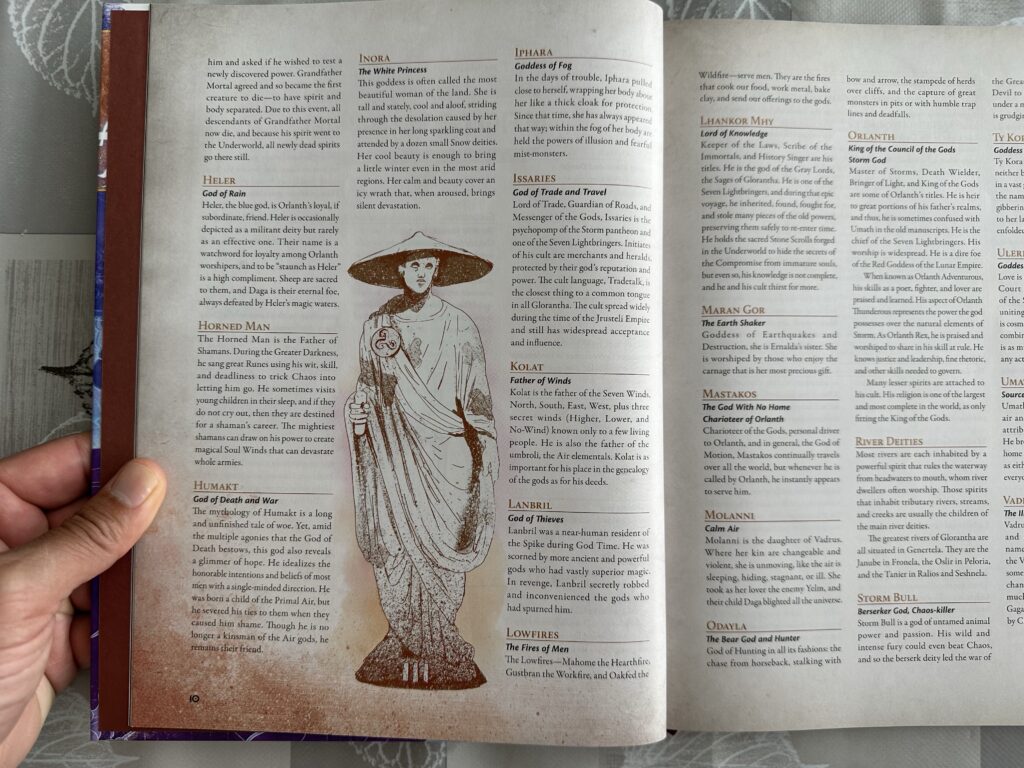
However, these places will be entirely unfamiliar to people who only own the RuneQuest rulebooks. This isn’t a problem per se, but an interesting question: will people make note of these mysterious places and develop their own Glorantha with them, like those playing RuneQuest in the early 1980s possibly did? Will they be annoyed at this obscure name-dropping? Or will they just go and buy the Guide to Glorantha? I’m hoping to hear from newcomers on this topic.
Cults Aren’t Classes
With the Lightbringers book giving new RuneQuest players their first look at a “full” cult write-up, it feels appropriate to ponder how cults differ from classes.
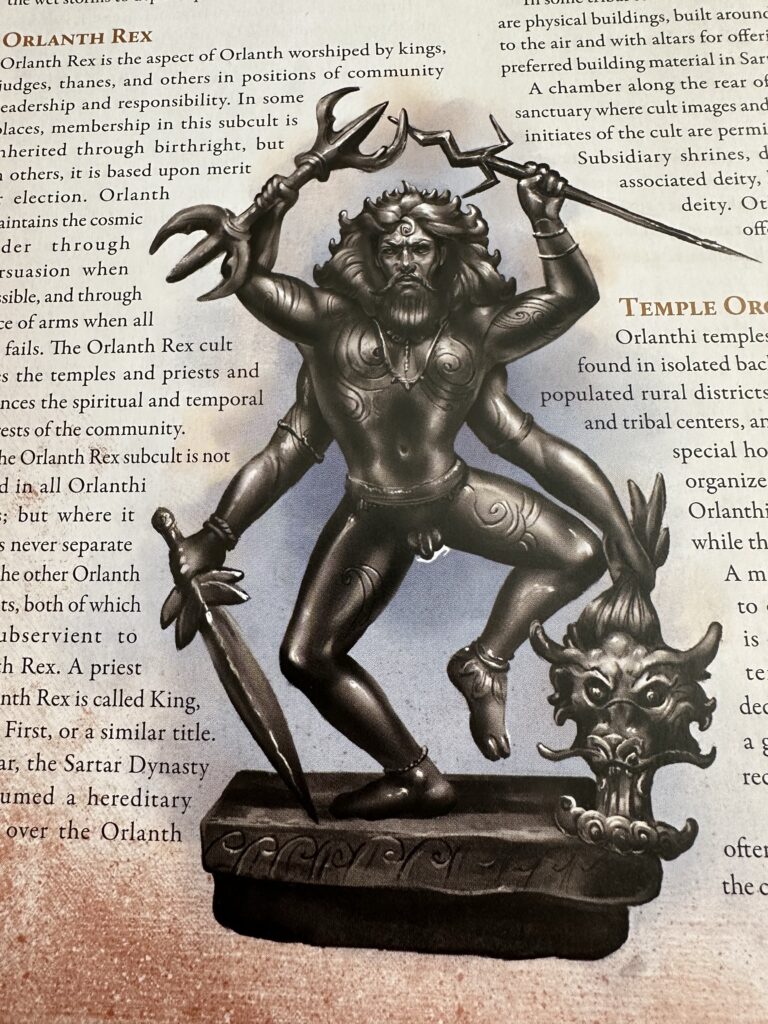
In a classic F20 game4You read that right: F20. I think the F stands for Fantasy. I didn’t coin this, Robin Laws did. (Dungeons & Dragons, Pathfinder, 13th Age, and so on), a character class defines your gameplay abilities and your progression over time. This tends to be purely limited to mechanics. How that class fits in the world, and how it’s roleplayed, is really up to you or to whatever setting you’re playing in. The “Barbarian” class might map to savage tribes from the northern mountains, or to the mightiest warriors in the imperial capital’s city watch, for instance.
On the other hand, part of the original appeal of RuneQuest as a skill-based system was that you are more free to do what you want with your character. Wearing armour, picking locks, casting healing spells, or being charismatic aren’t limited to any given class or cult. Some cults facilitate it, of course (the Lanbril thief will have an easier time learning lockpicking than the Chalana Arroy healer), but cults also define your character’s role and power within Gloranthan society. Unlike the Barbarian class, which only describes the mechanics of playing a berserker, the Storm Bull cultists are “socially unacceptable” and considered “mindless brutes, barely human, certainly deranged, and absolutely dangerous“. The Odayla worshipper only has access to a few wilderness shrines, while the Ernalda initiate enjoys many places of worship. Roleplay and position within the setting are therefore partially imposed by the cult, making it in some ways ironically more limiting than character classes.
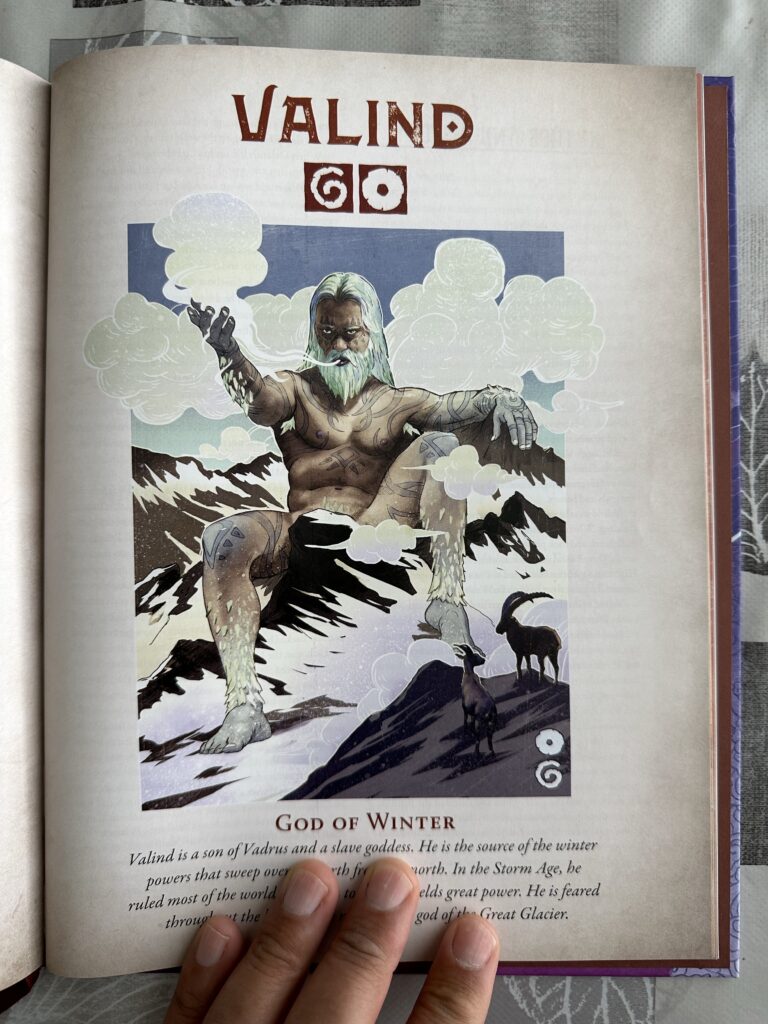
This isn’t a criticism: one of the strengths of RuneQuest is that the mechanics and the setting go hand-in-hand. This is a good thing: cults aren’t classes. They are closer to, say, Camarilla clans in Vampire: The Masquerade5“Mmh actually it’s the other way around”. Yes, I know. Mark Rein-Hagen was inspired by RuneQuest cults when he designed Vampire.. In that game, if you want to be a quick and strong vampire you can pick clan Brujah, but then you also have to wear leather, ride a motorbike, and listen to heavy-metal. Malkavians are deranged outcasts, Nosferatus are monsters who live in the shadows, Ventrues are rich assholes, and so on. Some clans are prominent or rigid, others are minor or disorganized. You get the idea, and the similarities.
You’re always free to be an outlier, of course (both in RuneQuest and Vampire: The Masquerade), but I feel this aspect of RuneQuest is worth mentioning, especially as we have many people coming over from Dungeons & Dragons. Gamemasters may need to manage expectations, there.
The Last Puzzle Piece
There are several lenses through which we can understand the cultures of Glorantha. The RuneQuest rulebook does it through character creation: Family History, character occupations, and the various bonuses related to each Homeland. The Glorantha Bestiary does it through the ecosystem in which adventurers live: what they communicate with, hunt, ride, fight, or kill. The Weapons & Equipment sourcebook does it through the material culture: what they own, ride, covet, steal, buy, or sell.
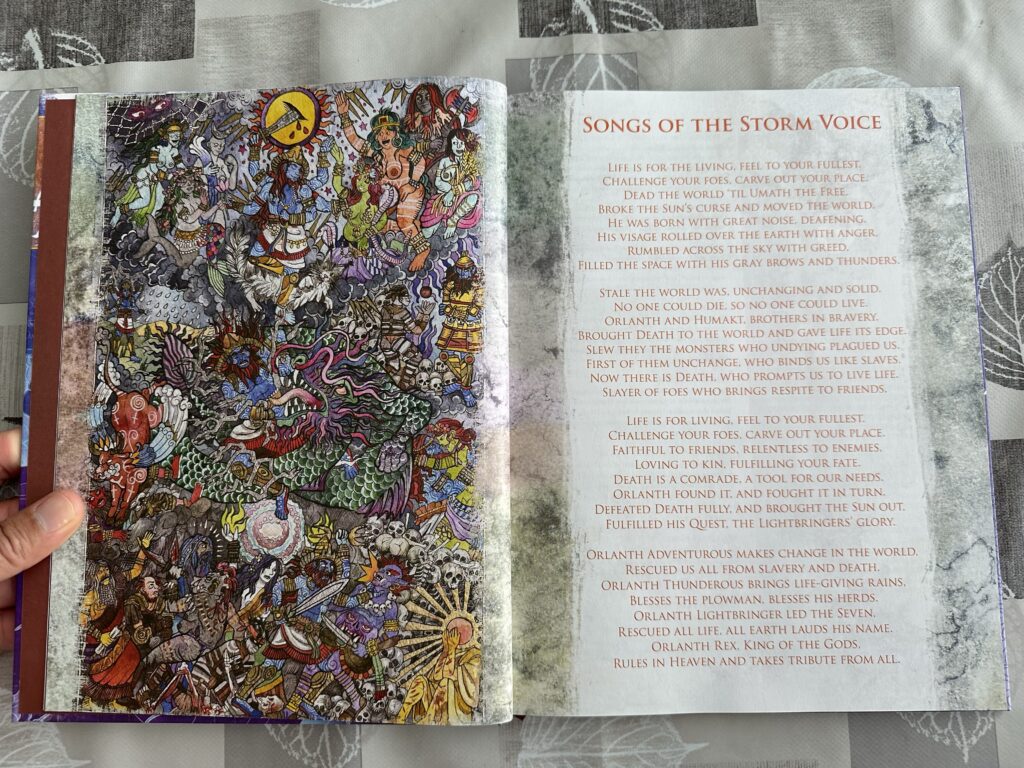
The Lightbringers book provides one of the biggest missing pieces of the puzzle: a view at the cultures of Glorantha through their religious beliefs and practices. The word “culture” shares the same root as “cult” after all. This in turn also gives us a look at the political organization of Glorantha, because religion and politics are pretty much the same in a Bronze or Iron Age world.
In the end, the large amount of world-building disseminated throughout is my favourite thing about this book. It’s what I liked about the Glorantha Bestiary and the Weapons & Equipment guide, and it’s what I love about the Lightbringers. Sections related to the history of a cult within Time, its social and political position, and its organization are the most ripe with it, but additional notes are also used to dump extra lore. For instance, there’s a column on trade in Glorantha in the Issaries chapter, and a description of Clown Societies in the Eurmal chapter.

Cults of RuneQuest: The Lightbringers is a must have for any RuneQuest player, and will be useful to anybody with an interest in Glorantha, whether it’s for playing in it, writing fiction about it, or whatever else floats your trireme.


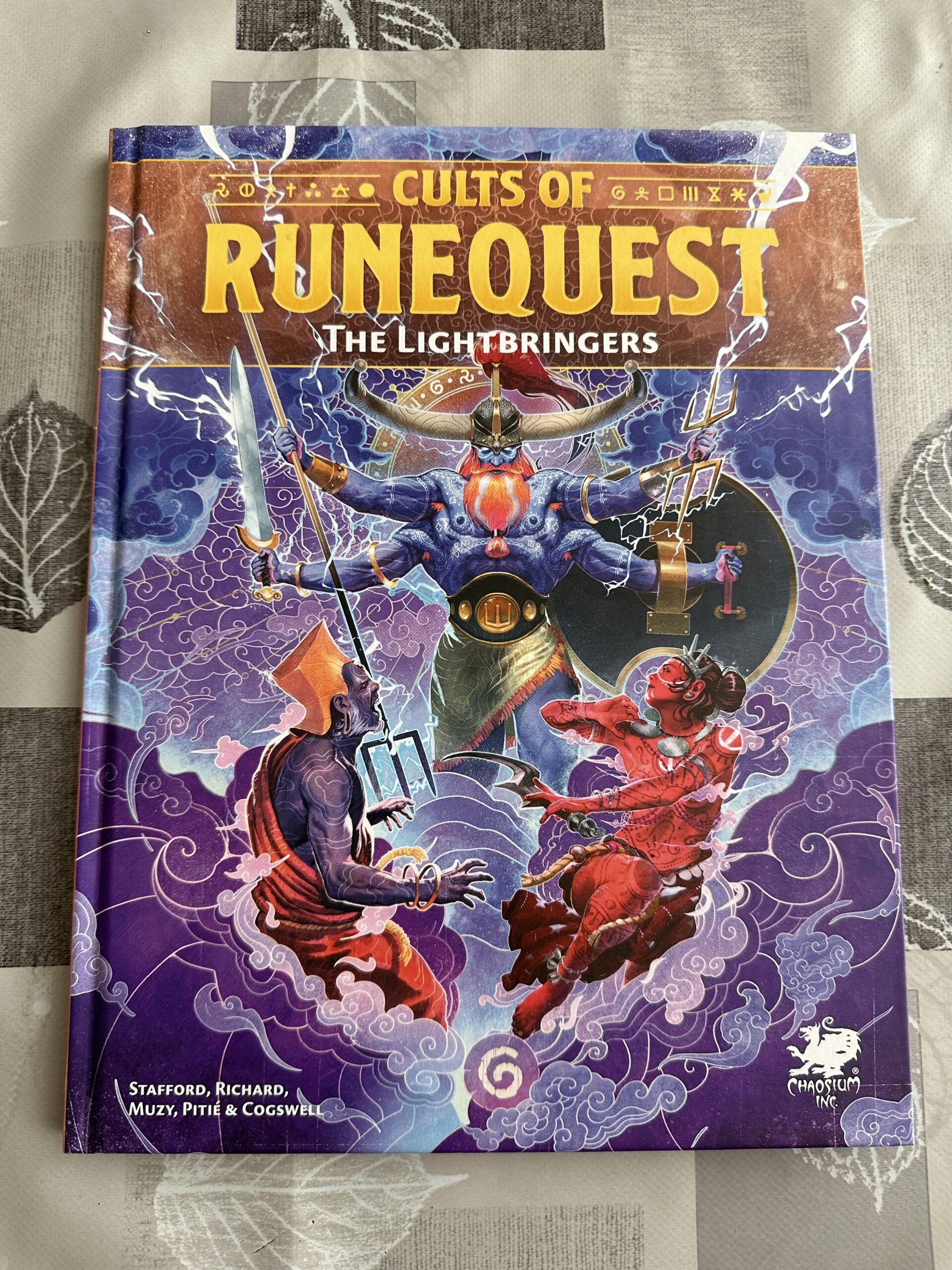
2 comments on “Review: Cults of RuneQuest: The Lightbringers”